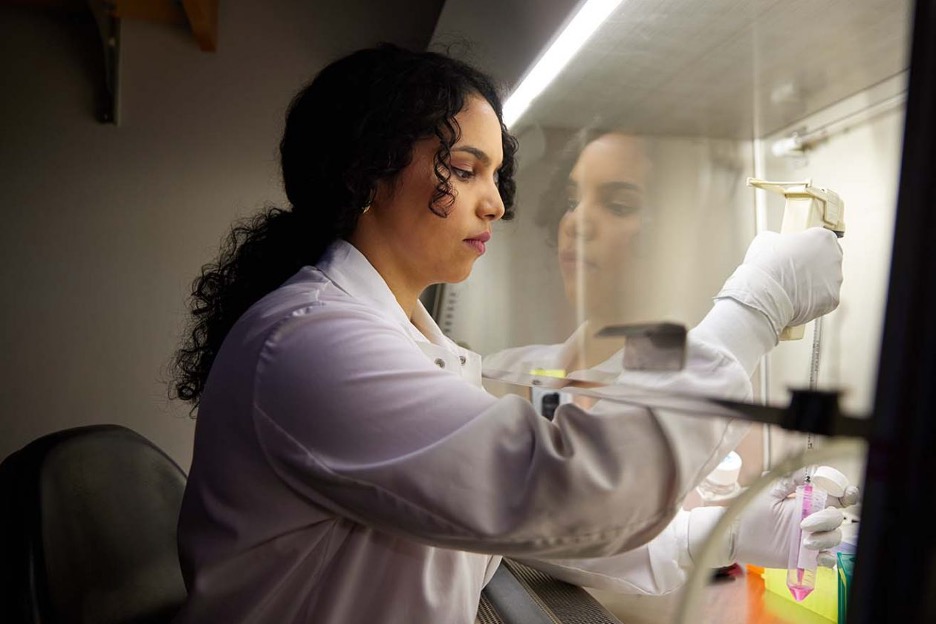
Pamela Ferdinand
September 21, 2022
MIT PHD STUDENT YAMI ACEVEDO-SÁNCHEZ DISCOVERED SHE ENJOYED SCIENCE by watching television at home in Puerto Rico. While a strong student, encouraged by her mentors and parents to do well, she never imagined a science career would be in her future.
Acevedo-Sánchez is the second member of her extended family—her mother has 17 brothers and sisters; her father has 11—to earn a college degree. She didn’t learn about MIT until she began studying at the University of Puerto Rico, and attending the Institute felt like a very big step.
“I remember my thoughts were, ‘I’m never going to make it there.’ It felt really, really out of reach,” she says. “But I don’t say ‘no’ to myself. I just go for it.”
Today at MIT, Acevedo-Sánchez is pursuing her passion for biology, working to understand the basic processes that make all the complexity of life possible. “To me, it seems like a puzzle waiting for someone to assemble the pieces,” she says.
Her research focuses on a fundamental question: How do bacterial pathogens hijack a host? By studying how they travel between cells and spur infection, she hopes to discover more about the diseases they cause and potential therapies.
In particular, she is focused on Listeria monocytogenes, a widespread bacterium that can cause food poisoning. In high-risk populations, such as pregnant women or immunocompromised individuals, it can spread to the liver and then move through the bloodstream into the rest of the body. Listeria infection (listeriosis) has a high mortality rate, killing an estimated 20% to 30% of those infected, according to the US Food and Drug Administration.
Listeria hijacks molecular pathways as it spreads from cell to cell. It typically forces itself into neighboring cells by ramming into cell junctions (spots where cells connect). The force and speed Listeria uses to do this is about 0.2–1 microns per second—the equivalent of 50 feet per second if Listeria were the size of a submarine, Acevedo-Sánchez says: “It’s very impressive to watch!”
What is the mechanism of this action? Is it random, or programmed and regulated by the bacteria or our cells? Working with assistant professor of biology Rebecca Lamason and others in Lamason’s lab, Acevedo-Sánchez hopes to answer such questions through groundbreaking work that visualizes the cell membrane dynamics as Listeria spreads from cell to cell. To do this, the team uses a cellular line with a membrane marker (developed by Lamason) and a confocal microscope, which can capture high-resolution images deep inside cells.
Acevedo-Sánchez is especially interested in exploring how the mechanisms of two proteins, CAV1 and PACSIN2, promote cell-to-cell spread over long distances in a short amount of time. “These pathogens are constantly interacting with their host,” she says. “By understanding the key players that mediate those interactions from the bacteria side as well as the cell side, we can understand more about the microbiology of the bacteria and our own cell biology.”
Mentoring others
Outside the lab, Acevedo-Sánchez is working to support others like her who have not always believed they could pursue careers in science, technology, engineering, and mathematics. “There is tremendous power in having someone believe in your ability,” she says.
She has served as a mentor for the MIT Summer Research Program in Biology and supported first-year biology graduate students through the BioPals Program. Acevedo- Sánchez has also presented her work to middle school students around the world through the video series MIT Abstracts.
“Anyone can be a scientist, regardless of their background,” says Acevedo-Sánchez, who also has served as a graduate diversity ambassador at MIT. “You just need three things: be curious about the world that surrounds you, be willing to ask questions, and do the work yourself. Work smart and hard.”
Pamela Ferdinand is a 2003–2004 MIT Knight Science Journalism Fellow
